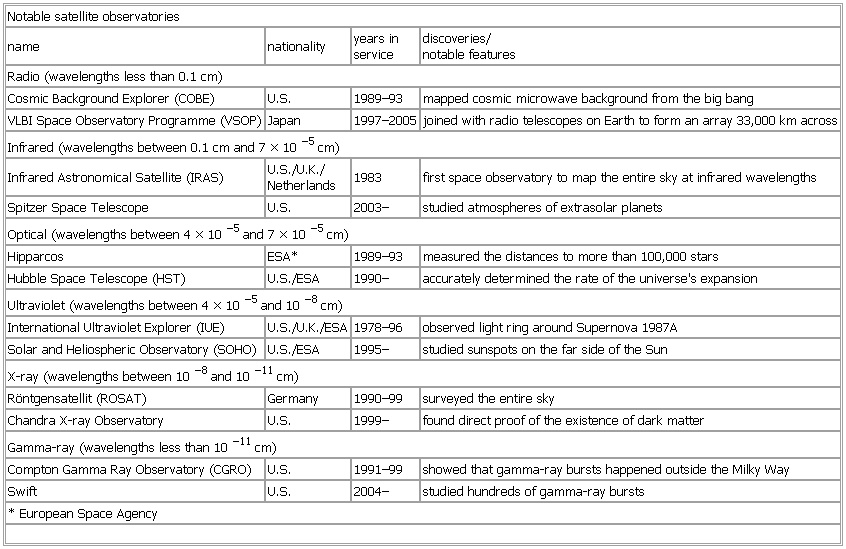Notable satellite observatories
- Notable satellite observatories
-
Notable satellite observatories
name nationality years in
service discoveries/
notable features
Radio (wavelengths less than 0.1 cm)
VLBI Space Observatory Programme (
VSOP)
Japan 1997–
2005 joined with radio telescopes (
telescope)
on Earth to form an array 33,
000 km across
Infrared (wavelengths between 0.1 cm and 7 × 10−5 cm)
Netherlands 1983 first space observatory to map the entire sky at infrared wavelengths
Optical (wavelengths between 4 × 10−5 and 7 × 10−5 cm)
Hipparcos ESA*
1989–
93 measured the distances to more than 100,
000 stars (
star)
Hubble Space Telescope (
HST) (
Hubble Space Telescope)
U.
S./
ESA 1990–
accurately determined the rate of the universe'
s expansion
Ultraviolet (wavelengths between 4 × 10−5 and 10−8 cm)
X-ray (wavelengths between 10−8 and 10−11 cm)
Röntgensatellit (ROSAT) Germany 1990–99 surveyed the entire sky
Gamma-ray (wavelengths less than 10−11 cm)
Swift U.S. 2004– studied hundreds of gamma-ray bursts
See as table:
* * *
Universalium.
2010.
Look at other dictionaries:
satellite observatory — ▪ astronomy Earth orbiting spacecraft that allows celestial objects and radiation to be studied from above the atmosphere. Astronomy from Earth s surface is limited to observation in those parts of the electromagnetic spectrum (see… … Universalium
eclipse — eclipser, n. /i klips /, n., v., eclipsed, eclipsing. n. 1. Astron. a. the obscuration of the light of the moon by the intervention of the earth between it and the sun (lunar eclipse) or the obscuration of the light of the sun by the intervention … Universalium
Comet — This article is about the astronomical object. For other uses, see Comet (disambiguation). Comet Hale– … Wikipedia
telescope — /tel euh skohp /, n., adj., v., telescoped, telescoping. n. 1. an optical instrument for making distant objects appear larger and therefore nearer. One of the two principal forms (refracting telescope) consists essentially of an objective lens… … Universalium
Mathematics and Physical Sciences — ▪ 2003 Introduction Mathematics Mathematics in 2002 was marked by two discoveries in number theory. The first may have practical implications; the second satisfied a 150 year old curiosity. Computer scientist Manindra Agrawal of the… … Universalium
Physical Sciences — ▪ 2009 Introduction Scientists discovered a new family of superconducting materials and obtained unique images of individual hydrogen atoms and of a multiple exoplanet system. Europe completed the Large Hadron Collider, and China and India took… … Universalium
Scientific research in Canada — This article outlines the history of natural scientific research in Canada including, mathematics, physics, astronomy, space science, geology, oceanography, chemistry, biology, medical research and psychology. The social sciences are not treated… … Wikipedia
Natural scientific research in Canada — This article outlines the history of natural scientific research in Canada, including mathematics, physics, astronomy, space science, geology, oceanography, chemistry, biology, medical research and psychology. The social sciences are not treated… … Wikipedia
astronomical observatory — any structure containing telescopes and auxiliary instruments with which to observe celestial objects. Observatories can be classified on the basis of the part of the electromagnetic spectrum in which they are designed to observe. The… … Universalium
Goddard Space Flight Center — NASA Goddard Space Flight Center Aerial view of Goddard Space Flight Center … Wikipedia

